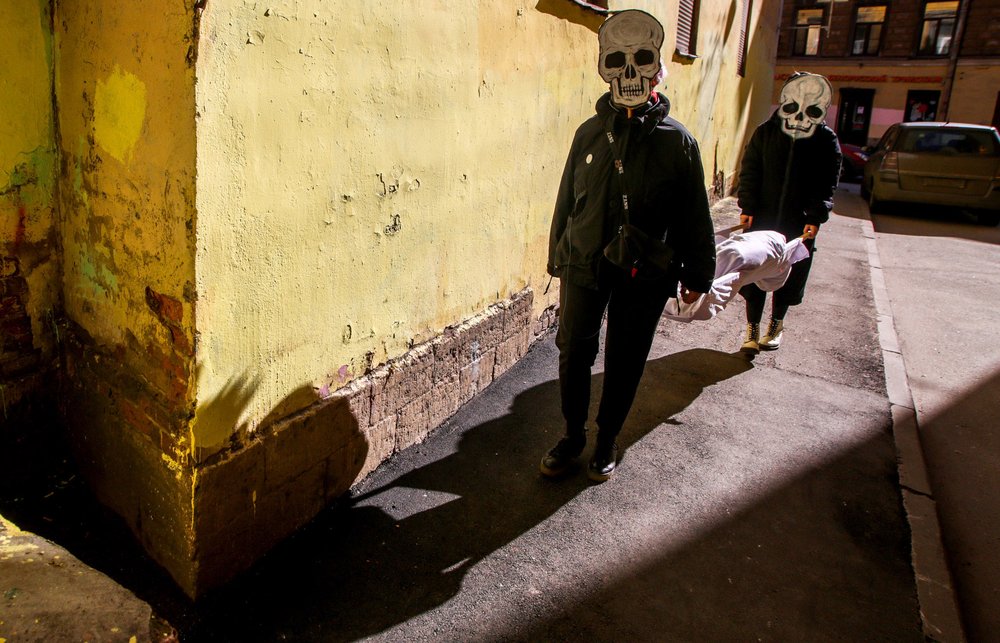Cast your vote for the dead

Dead in a dead city, April 5, 2020. Street performance. Photo by Eugeny Kurskov
Saint Petersburg’s ‘Party of the Dead’ is an art collective, which has a bone to pick with the political establishment. Discover Russian Political Art in an Age of the Absurd.
Stooped figures carrying what looks like a body through streets emptied by the pandemic. Wrapped “corpses” in city parks. Lines of protesters hoisting banners with slogans like “JOIN US” and “THE DEAD OUTNUMBER THE LIVING”. You might think that it’s all a joke, but you’d only be half right – the ‘Party of the Dead’, a political art collective founded by Maxim Evstropov (b. 1979) and Darya Apakhonchich (b. 1985) (declared a foreign agent by the Russian authorities), will remind you they’re deadly serious.
The Party takes its inspiration from political revolutionaries. “This is the voice of the dead,” says their manifesto before decrying the injustices of war, corporations and government: “If the living will fight no more, the dead will.” Their tone is tongue-in-cheek, but the group tackles weighty subject material. Party members can be seen, often in skull masks or white make-up, holding signs protesting war (“The dead don’t fight”), offering solidarity (“There’s more of us”) and challenging the president’s increased term in power (“Eternity smells like Putin”). Given that the ability to demonstrate has been curtailed in the country over the past few years, the group claims that staking out space for the expression of unpopular opinions is as important as ever.
The Party first made national headlines in the summer of 2018, when they were ordered by the court to destroy a piece of visual art. The offending poster, “9 Stages in the Decomposition of the Leader” by {rodina} group, depicts a series of nine time-lapsed panels, in which a picture of Vladimir Putin decomposes over time into a seed box. It was carried along the streets during the May Day march by activist, lawyer and Party member Varya Mikhailova (b. 1991), who was later detained. The court established that the image did not comply “with the declared purpose of the march” that day, initiating the first court-mandated destruction of art in the post-Soviet period. The image, however, soon found its way across the internet (and various pieces of merchandise) and the Party continues to devise innovative, playful and absurd ways to challenge a political system that grows more concerning each year. During the pandemic, the Party has mounted a number of projects. One, in which four members carried a “corpse” wrapped in plastic through deserted Saint Petersburg streets, was documented as a way to grapple with the shocking wave of events rocking the country. On another occasion, Evstropov and another member, Maria Vonogova (b. 1991), lay covered in similar plastic wrapping in one of the city’s parks to protest at how family members were not allowed to say goodbye to their departed loved ones, due to COVID-19 measures. “Don’t say goodbye, we’ll see each other soon,” their posters said. However, even these playful attempts to deal with death and absurdity have attracted negative attention from the authorities. Evstropov and Vonogova were later detained at their homes for breaking self-isolation, a move that has gained criticism, because the park was full of people relaxing at a distance from each other.
Political artists in general have faced additional barriers over the past few months, as additional laws restricting public expression have been passed by the local parliament. Apakhonchich, after leaving the Party, found herself labelled a “foreign agent”, due to her own work supporting persecuted feminist activists, and the future remains uncertain for many. That said, as Evstropov and his team remind us, death is one of the few true certainties. And so, the Party continues their march, assembling a fabled necro-international and working towards the necro-revolution. And, in spite of everything, their manifesto remains defiant. “Join the party of the dead,” it reads. “Choosing the party, you choose the future. Tomorrow belongs to us.”









